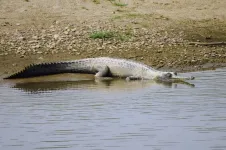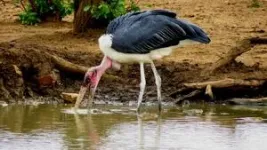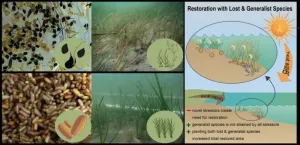Unveiling nature's custodians: groundbreaking study highlights crucial role of scavengers in wetlands
Researchers conducted a comprehensive analysis of over 200 scientific articles spanning six decades, elucidating the role of scavengers in wetland ecosystems across the globe
2024-04-30
(Press-News.org)
A pioneering study highlights the importance of carrion and scavengers in wetlands on a global scale. A study by researchers from the Ecology area of the Miguel Hernández University of Elche (UMH) and the Ecology department of the University of Alicante (UA) reveals the fundamental importance of scavengers and carrion in wetlands. The article, published in Biological Reviews, emphasizes that the benefits provided by scavengers far outweigh the potential drawbacks. Among their essential functions are the recycling and transportation of nutrients and the regulation of water quality, benefiting the entire ecosystem, from soil and plants to birds and mammals.
Historically, animals that feed on other dead animals have received less attention from society, and they have even been assigned a secondary role in ecosystems. However, recent studies have shown that scavengers play a crucial ecological role in eliminating organic matter and rapidly recycling nutrients into the ecosystem. But despite the increased knowledge and interest in this group of animals in recent decades, most scientific attention has focused on the role of scavengers in terrestrial ecosystems, ignoring their function in ecosystems as important as wetlands.
Wetlands are vital ecosystems because they regulate the water cycle and prevent floods. They are critical habitats for diverse species, from migratory birds to fish and aquatic plants. At the same time, they provide essential ecosystem services such as water purification and carbon sequestration, significantly contributing to global environmental health. However, despite these critical functions, they are one of the most threatened habitats by human activities: it is estimated that between 64% and 71% of the planet's wetlands have disappeared in the last century.
To understand the role of scavengers in wetlands, researchers from the Ecology area of the UMH and the UA analyzed more than 200 scientific articles conducted over the past 60 years worldwide. One conclusion of this analysis is that scientific knowledge is not spatially homogeneous. North America - with 70% of scientific papers - and Europe - with 14% - concentrated most of the research. This highlights a significant need for studies in other parts of the world. However, geographic differences are not the only ones found. Some wetlands, such as rivers and streams, receive much more scientific attention than lakes, ponds, or marshes. Both results indicate the need to refocus new research to fully understand the role of scavengers in aquatic ecosystems globally, diversifying research both geographically and in habitat types.
Contrary to the generally extended idea that only a small group of species consume dead animals, researchers found significant species diversity. There are 176 families of scavengers among small invertebrates, such as flies and beetles. Also, 114 species of vertebrates distributed in 40 families of birds and mammals scavenge. By analyzing each study in detail, researchers found that during the carrion consumption process, these organisms performed up to five different functions in the ecosystem, including nutrient recycling, water quality regulation, and pathogen control. This diversity of species and functions underscores the critical importance of scavengers in the health and balance of wetlands worldwide.
Most (85%) of the analyzed publications conclude that carrion positively affects all ecosystem components, from soil to large vertebrates. Therefore, according to the study conducted by researchers from UMH and UA, improving our understanding of scavengers and carrion in wetlands is crucial to assessing their current and future functions amidst global change. In particular, it would be helpful to understand the movement of essential nutrients for life, such as phosphorus or nitrogen, which are limiting in some ecosystems. They also recommend making more efforts to understand their influence on disease control, as an increase in the occurrence and magnitude of mass mortality events is expected. This knowledge will enable more effective management of wetlands and contribute to their long-term conservation.
This study has been published in the journal Biological Reviews and was carried out by a multidisciplinary team composed of researchers Adrian Orihuela Torres and Esther Sebastián González from UA and researchers from the Ecology area of UMH, José Antonio Sánchez Zapata, Francisco Botella, and Juan Manuel Pérez-García; in collaboration with researchers from the Institute of Advanced Social Studies (IESA-CSIC), the Doñana Biological Station (EBD-CSIC), the University of Granada, and the University of Murcia.
END
ELSE PRESS RELEASES FROM THIS DATE:
2024-04-30
As a result, the researchers recommend updating the information requirements in the EU legislation, REACH. They also propose various approaches for evaluating chemical substances to ensure that all available information is fully utilized.
Researchers from DTU National Food Institute and the University of Southern Denmark have screened the scientific literature for the Danish Environmental Protection Agency to find substances showing signs of endocrine disrupting properties and thus being potentially harmful to humans and ...
2024-04-30
A substantial proportion of the world’s population remains willing to get vaccinated against diseases including COVID-19, according to a new survey across 23 countries that represent more than 60% of the world’s population. The study, published in Nature Medicine, was co-led by the Barcelona Institute for Global Health (ISGlobal), a centre supported by “la Caixa” Foundation, and the Graduate School of Public Health and Health Policy of the City University of New York (CUNY SPH).
The severe human impact of the COVID-19 pandemic led to the rapid research and development of safe and effective vaccines based on existing models, ...
2024-04-30
An entirely new approach to inhibiting DNA-cleaving enzymes works through the aggregation of an otherwise non-toxic molecule. This Kobe University discovery may lead to a much-needed method for curbing Streptococcus growth.
Enzymes are the body’s tools to make almost all reactions happen. But the same is true for bacteria like Streptococcus, which causes toxic shock syndrome, a rapidly progressing and deadly condition. When the body’s white blood cells try to capture the bacteria by casting nets made out ...
2024-04-30
What do the flow of cars on a highway and the movement of bacteria towards a food source have in common? In both cases, annoying traffic jams can form. Especially for cars, we might want to understand how to avoid them, but perhaps we've never thought of turning to statistical physics, as Alexandre Solon, a physicist from Sorbonne Université, and Eric Bertin, from the University of Grenoble, both working for the Centre national de la recherche scientifique CNRS, have done. Their research, recently published in the Journal of Statistical Mechanics: Theory and Experiment (JSTAT), has developed a one-dimensional mathematical model ...
2024-04-30
New research demonstrates that seagrass habitat restoration can be enhanced by including other grasses in addition to the declining or lost species and – ultimately – that restoration efforts must proactively select species that can withstand current and intensifying stressors driven by human activities and climate change.
Rising global temperatures combined with centuries of humans working within our seascapes has reshaped coastal ecosystems. Rebuilding or restoring coastal habitat is becoming ...
2024-04-30
New research co-authored by a UC Riverside business professor provides some sound advice for managers of retail outlets that limit their product selection to a particular brand: Managers should factor in the strength of their brand when structuring the pay incentives for their sales staff.
The study focused on what marketing scholars call “brand-managed” retail operations. These outlets include “stores within stores,” such as counters in major department stores with dedicated sales staff that offer just one brand of cosmetics such as Clinique. They can also be stores ...
2024-04-30
The fearsome, saber-like teeth of Smilodon fatalis — California's state fossil — are familiar to anyone who has ever visited Los Angeles' La Brea Tar Pits, a sticky trap from which more than 2,000 saber-toothed cat skulls have been excavated over more than a century.
Though few of the recovered skulls had sabers attached, a handful exhibited a peculiar feature: the tooth socket for the saber was occupied by two teeth, with the permanent tooth slotted into a groove in the baby tooth.
Paleontologist Jack Tseng, associate professor of integrative biology at the University of California, Berkeley, doesn't think the double fangs ...
2024-04-30
When COVID-19 caused significant economic disruptions, thousands of people around the world experienced sudden shocks to their financial situation through reduced earnings or job losses.
Now economic researchers at the University of South Australia have examined the mental health effects on people who experienced immediate or expected financial setbacks during the height of the pandemic.
Data gathered from China, Japan and South Korea during the early phases of the pandemic revealed that the severe economic shocks induced by COVID-19 caused significant ...
2024-04-30
A healthy lifestyle may offset the effects of life-shortening genes by more than 60%, suggests an analysis of the findings from several large long term studies, published online in the journal BMJ Evidence Based Medicine.
While genes and lifestyle seem to have an additive effect on a person’s lifespan, an unhealthy lifestyle is independently linked to a 78% heightened risk of dying before one’s time, regardless of genetic predisposition, the research indicates.
The polygenic risk score (PRS) combines ...
2024-04-30
Frequent teen vaping might boost the risk of exposure to lead and uranium, potentially harming brain and organ development, suggests research published online in the journal Tobacco Control.
The findings underscore the need for implementation of regulations and prevention efforts targeting teens, emphasise the researchers.
Vaping is popular with teens. In 2022, an estimated 14% of US high school students—around 2.14 million—and more than 3% of middle school students—around 380,000—reported vaping in the preceding month, note the researchers.
Certain metals have been identified in e-cigarette aerosols and ...
LAST 30 PRESS RELEASES:
[Press-News.org] Unveiling nature's custodians: groundbreaking study highlights crucial role of scavengers in wetlands
Researchers conducted a comprehensive analysis of over 200 scientific articles spanning six decades, elucidating the role of scavengers in wetland ecosystems across the globe








